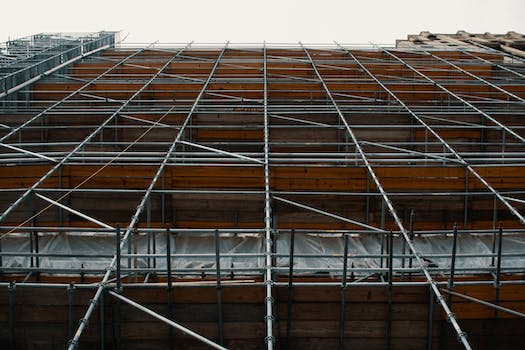How To Build A Modern House
“Design and build your dream home with modern style and functionality.”
Introduction
Building a modern house requires careful planning and attention to detail. From selecting the right materials to designing the layout, every aspect of the construction process must be considered to create a functional and stylish home. In this article, we will provide an overview of the key steps involved in building a modern house, including site selection, design, and construction. Whether you are a homeowner looking to build your dream home or a builder seeking to create a unique and innovative project, this guide will help you get started on the path to success.
Maximizing Natural Light in Your Modern Home Design
Building a modern house is an exciting project that requires careful planning and attention to detail. One of the most important aspects of modern home design is maximizing natural light. Natural light not only enhances the aesthetic appeal of your home but also has numerous health benefits. In this article, we will discuss some tips on how to maximize natural light in your modern home design.
The first step in maximizing natural light is to choose the right location for your home. Ideally, your home should be situated in an area that receives plenty of sunlight throughout the day. This will ensure that your home is naturally well-lit, reducing the need for artificial lighting during the day.
Another important factor to consider is the orientation of your home. The orientation of your home will determine how much natural light it receives. Ideally, your home should be oriented to face south or west to maximize natural light. This will ensure that your home receives plenty of sunlight throughout the day, especially during the winter months when the sun is lower in the sky.
Once you have chosen the right location and orientation for your home, the next step is to design your home to maximize natural light. One of the most effective ways to do this is to incorporate large windows and skylights into your home design. Large windows and skylights allow natural light to flood into your home, creating a bright and airy atmosphere.
When choosing windows for your home, it is important to choose high-quality windows that are energy-efficient. Energy-efficient windows will not only help to maximize natural light but also help to reduce your energy bills by keeping your home well-insulated.
In addition to windows and skylights, another effective way to maximize natural light is to use light-colored materials in your home design. Light-colored walls, floors, and ceilings reflect natural light, making your home feel brighter and more spacious.
Another important factor to consider when designing your home is the placement of furniture and accessories. It is important to avoid placing furniture and accessories in areas that block natural light. Instead, try to arrange your furniture in a way that allows natural light to flow freely throughout your home.
Finally, it is important to maintain your windows and skylights to ensure that they continue to maximize natural light. Regular cleaning and maintenance will help to keep your windows and skylights clear and free from dirt and debris, allowing natural light to flood into your home.
In conclusion, maximizing natural light is an important aspect of modern home design. By choosing the right location and orientation for your home, incorporating large windows and skylights, using light-colored materials, and arranging your furniture in a way that allows natural light to flow freely, you can create a bright and airy atmosphere in your home. With these tips, you can build a modern home that is not only beautiful but also healthy and energy-efficient.
Incorporating Sustainable Materials into Your Modern Home Build

Building a modern house is an exciting project that requires careful planning and consideration. One of the most important aspects of building a modern home is incorporating sustainable materials into the design. Sustainable materials not only reduce the environmental impact of your home but also provide long-term cost savings. In this article, we will discuss some of the sustainable materials you can use in your modern home build.
The first sustainable material to consider is bamboo. Bamboo is a fast-growing plant that is highly renewable and sustainable. It is also incredibly strong and durable, making it an excellent choice for flooring, cabinets, and furniture. Bamboo flooring is a popular choice for modern homes because it is easy to maintain and has a sleek, modern look.
Another sustainable material to consider is reclaimed wood. Reclaimed wood is wood that has been salvaged from old buildings, barns, and other structures. Using reclaimed wood in your modern home build not only adds character and warmth to your home but also reduces the demand for new wood products. Reclaimed wood can be used for flooring, walls, and even furniture.
Recycled glass is another sustainable material that can be used in your modern home build. Recycled glass can be used for countertops, backsplashes, and even flooring. It is a durable and eco-friendly alternative to traditional materials like granite and marble. Recycled glass comes in a variety of colors and patterns, making it a versatile choice for modern homes.
When it comes to insulation, consider using natural materials like wool or cellulose. These materials are renewable, non-toxic, and provide excellent insulation. They are also more energy-efficient than traditional insulation materials like fiberglass. Natural insulation materials can be used in walls, floors, and ceilings to keep your home comfortable and energy-efficient.
Solar panels are another sustainable addition to your modern home build. Solar panels can be used to generate electricity and heat water, reducing your reliance on traditional energy sources. They are a long-term investment that can provide significant cost savings over time. Solar panels can be installed on the roof or on the ground, depending on your home’s location and orientation.
Finally, consider using low-VOC (volatile organic compound) paints and finishes in your modern home build. Low-VOC paints and finishes are non-toxic and emit fewer harmful chemicals into the air. They are a healthier choice for your family and the environment. Low-VOC paints and finishes come in a variety of colors and finishes, making it easy to achieve the look you want in your modern home.
In conclusion, incorporating sustainable materials into your modern home build is an excellent way to reduce your environmental impact and save money in the long run. Bamboo, reclaimed wood, recycled glass, natural insulation materials, solar panels, and low-VOC paints and finishes are all sustainable materials that can be used in your modern home build. By choosing these materials, you can create a beautiful, eco-friendly home that is both stylish and sustainable.
Creating an Open Floor Plan for Your Modern Home
Building a modern house is an exciting project that requires careful planning and attention to detail. One of the most important aspects of modern home design is creating an open floor plan. An open floor plan is a layout that eliminates walls and barriers between rooms, creating a seamless flow between spaces. This design concept is popular in modern homes because it promotes a sense of spaciousness, flexibility, and connectivity.
To create an open floor plan for your modern home, you need to consider several factors. First, you need to determine the purpose of each room and how they will be used. For example, if you plan to entertain guests frequently, you may want to have a large living room that flows into the dining area and kitchen. If you work from home, you may need a dedicated office space that is separate from the rest of the living areas.
Once you have a clear idea of the purpose of each room, you can start to think about the layout. One of the most effective ways to create an open floor plan is to eliminate walls between the living areas. This can be achieved by using large sliding doors, pocket doors, or even removing entire walls. By doing so, you can create a seamless flow between the living room, dining area, and kitchen.
Another way to create an open floor plan is to use furniture to define the different areas. For example, you can use a sofa or a rug to create a boundary between the living room and dining area. This approach allows you to maintain a sense of separation between the different areas while still promoting a sense of openness.
Lighting is also an important factor in creating an open floor plan. Natural light is ideal, as it can help to create a sense of spaciousness and warmth. If your home does not have a lot of natural light, you can use artificial lighting to create a similar effect. For example, you can use recessed lighting or pendant lights to create a warm and inviting atmosphere.
When designing an open floor plan, it is important to consider the flow of traffic. You want to ensure that there is enough space for people to move around comfortably without feeling cramped. You can achieve this by creating wide walkways and using furniture that is proportional to the size of the room.
Finally, it is important to consider the overall aesthetic of your modern home. An open floor plan can be a great way to showcase your personal style and create a cohesive design throughout the living areas. You can use color, texture, and materials to create a sense of continuity between the different areas.
In conclusion, creating an open floor plan is an essential aspect of modern home design. By eliminating walls and barriers between rooms, you can create a seamless flow between the living areas, promote a sense of spaciousness, and showcase your personal style. When designing an open floor plan, it is important to consider the purpose of each room, the layout, lighting, traffic flow, and overall aesthetic. With careful planning and attention to detail, you can create a modern home that is both functional and beautiful.
Choosing the Right Color Palette for Your Modern Home Interior
Building a modern house is an exciting project that requires careful planning and attention to detail. One of the most important aspects of building a modern home is choosing the right color palette for your interior. The color scheme you choose will set the tone for your home and create a cohesive look throughout the space. In this article, we will discuss some tips for choosing the right color palette for your modern home interior.
First, it’s important to understand the basics of color theory. Colors can be divided into warm and cool tones. Warm colors, such as red, orange, and yellow, create a cozy and inviting atmosphere. Cool colors, such as blue, green, and purple, create a calming and relaxing atmosphere. Neutral colors, such as white, gray, and beige, can be used to balance out the warm and cool tones and create a sophisticated look.
When choosing a color palette for your modern home interior, it’s important to consider the overall style of your home. Modern homes typically have clean lines, minimalistic design, and a focus on functionality. As such, it’s best to choose a color palette that reflects this style. Neutral colors, such as white, gray, and beige, are a great choice for modern homes as they create a clean and sophisticated look.
However, this doesn’t mean that you can’t add pops of color to your modern home interior. In fact, adding a few bold accents can create a striking contrast and add visual interest to your space. When choosing accent colors, it’s important to choose colors that complement your neutral color palette. For example, if you have a gray color scheme, you could add pops of yellow or blue to create a bold and modern look.
Another important factor to consider when choosing a color palette for your modern home interior is lighting. Natural light can have a significant impact on the way colors appear in your home. As such, it’s important to consider the direction and intensity of natural light in your space when choosing a color palette. If your home receives a lot of natural light, you may want to choose lighter colors to create a bright and airy atmosphere. On the other hand, if your home has limited natural light, you may want to choose warmer colors to create a cozy and inviting atmosphere.
In addition to natural light, it’s also important to consider artificial lighting when choosing a color palette for your modern home interior. Different types of lighting can create different moods and atmospheres in your home. For example, warm lighting can create a cozy and inviting atmosphere, while cool lighting can create a modern and sophisticated look. When choosing a color palette, it’s important to consider how your lighting will affect the way colors appear in your space.
In conclusion, choosing the right color palette for your modern home interior is an important aspect of building a modern house. By understanding the basics of color theory, considering the overall style of your home, and taking into account natural and artificial lighting, you can create a cohesive and modern look throughout your space. Remember to have fun with your color choices and don’t be afraid to add pops of bold color to create a striking contrast. With these tips in mind, you can create a modern home interior that is both functional and stylish.
Adding Smart Home Technology to Your Modern Home Design
Building a modern house is an exciting project that requires careful planning and attention to detail. One of the most important aspects of modern home design is incorporating smart home technology. Smart home technology allows you to control various aspects of your home, such as lighting, temperature, and security, from your smartphone or tablet. In this article, we will discuss how to add smart home technology to your modern home design.
The first step in adding smart home technology to your modern home design is to determine your needs. What aspects of your home do you want to control remotely? Do you want to be able to adjust the temperature from your smartphone? Do you want to be able to turn off the lights from your bed? Once you have determined your needs, you can begin researching the various smart home technologies available.
One of the most popular smart home technologies is a smart thermostat. A smart thermostat allows you to control the temperature of your home remotely. You can adjust the temperature from your smartphone or tablet, ensuring that your home is always at the perfect temperature. Some smart thermostats even learn your habits and adjust the temperature automatically, saving you money on your energy bills.
Another popular smart home technology is smart lighting. Smart lighting allows you to control the lights in your home remotely. You can turn off the lights from your bed or adjust the brightness from your smartphone. Some smart lighting systems even allow you to set schedules, so your lights turn on and off automatically.
Smart home security is also an important aspect of modern home design. Smart security systems allow you to monitor your home remotely and receive alerts if there is any suspicious activity. You can also control your security system remotely, ensuring that your home is always secure.
When adding smart home technology to your modern home design, it is important to consider the compatibility of the various systems. Some smart home technologies are not compatible with others, so it is important to do your research before making any purchases. You should also consider the installation process and whether you will need to hire a professional to install the systems.
In addition to adding smart home technology, there are other aspects of modern home design that you should consider. For example, open floor plans are a popular feature of modern homes. An open floor plan allows for a seamless flow between the various living spaces in your home. You should also consider incorporating natural materials, such as wood and stone, into your modern home design.
In conclusion, adding smart home technology to your modern home design is an important aspect of creating a comfortable and convenient living space. By determining your needs and researching the various smart home technologies available, you can create a home that is tailored to your lifestyle. Remember to consider compatibility and installation when making your purchases, and don’t forget to incorporate other modern design features, such as open floor plans and natural materials. With careful planning and attention to detail, you can create a modern home that is both stylish and functional.
Conclusion
Conclusion: Building a modern house requires careful planning, attention to detail, and the use of innovative materials and technologies. It is important to work with experienced architects and builders who can help you create a design that meets your needs and fits your budget. By incorporating sustainable features and energy-efficient systems, you can create a home that is not only stylish and comfortable but also environmentally friendly and cost-effective in the long run. With the right approach, building a modern house can be a rewarding and fulfilling experience that results in a beautiful and functional home for you and your family.






